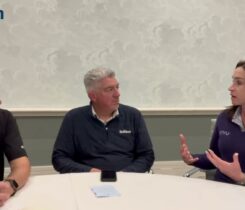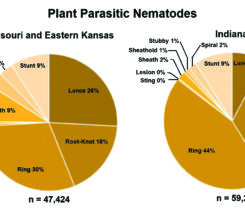On the lookout for nematodes

Clark Throssell
Clark Throssell interviews Jim Kerns, Ph.D., about nematodes. Kerns is a turfgrass pathologist at North Carolina State University. In addition to conducting research on turfgrass diseases, Kerns and his team devote considerable time to understanding nematodes, the problems they cause and their management. You may reach Kerns at jpkerns@ncsu.edu for more information.
Q: How widespread are nematodes on golf courses?
Nematodes are the most abundant animal on the planet, and every golf course has them. They are obligate parasites, meaning that to survive, they must feed on living root tissue. We conducted a nematode survey on golf courses in North Carolina in 2012-13 and found them on all golf courses we sampled, often with populations above threshold levels.
I want to stress that the presence of nematodes doesn’t equal damage, and published thresholds for nematode damage are just guides. Nematode counts can be deceiving. The healthier the roots, the more nematodes present. Determining a course of treatment depends on factors such as health of the turf, weather, time of year, past experience with nematode damage, budget and upcoming events. Before deciding whether to treat for nematodes, discuss your situation with someone who has knowledge of your golf course and experience working with nematodes to help interpret nematode counts. The decision to treat with a nematicide varies from golf course to golf course. Some greens can tolerate higher populations of nematodes than others.
Nematode damage is almost always seen on putting greens because of stress from low mowing heights and traffic. You may find nematodes on creeping bentgrass, annual bluegrass and bermudagrass greens.
Q: Describe the results of research you have done on sting and root-knot nematode biology.
Sting and root-knot nematodes are the most common species of turf-damaging nematodes in North Carolina. We learned that sting nematodes are most active in early spring when soil temperatures are 60 degrees F. Superintendents should treat greens with a history of unacceptable sting nematode damage with a nematicide in April. During the hot summer months, sting nematodes are inactive and are found 6 to 8 inches deep in the soil profile.
Root-knot nematodes are active in May when soil temperatures are 65 to 70 degrees F, and they remain active and reproduce during summer. Treat root-knot nematodes in May or June. You will most likely require two to three follow-up applications.
Q: What are the procedures for sampling for nematodes?
We recommend sampling if you are uncertain you have a nematode problem and on golf courses with a history of nematode populations. Sample before stress periods because nematode populations are at their highest when the root system is healthiest. Once the health of the turf and root system declines, the nematode population will decline as well.
Each diagnostic lab has specific procedures to follow when collecting a sample for nematode analysis. For our lab at North Carolina State, we require 500 cubic centimeters of soil from each green or area sampled. We recommend breaking down a green into four sections of similar size and taking 15 or 20 soil cores 1 inch in diameter to a depth of 6 inches from each section. Remove the turf and combine all individual samples into a single composite sample for a given green.
There is tremendous variability in nematode populations within a green. You may see low numbers of nematodes in one location, but 6 feet away, you may see a high population. It’s possible to get an accurate nematode count by collecting a large number of soil cores from a green.
Q: Once nematodes are identified as present through sampling, will they be present every year?
Yes, they will be present every year, but they may not cause turf damage every year. Damage depends on weather and the amount of stress present from mowing at low heights.
Q: Is there anything else you would like to add?
There is a possible interaction between the presence of turf-damaging nematodes and root-borne fungal diseases. While an interesting problem, it will be a difficult one to sort out.












